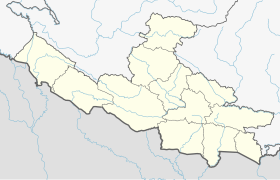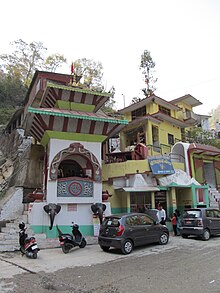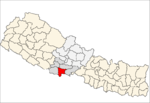Butwal
hideThis article has multiple issues. Please help or discuss these issues on the talk page. (Learn how and when to remove these template messages)
|
Butwal
बुटवल | |
|---|---|
Sub-Metropolitan City | |
 Butwal city from hillside. | |
 Butwal Location of Butwal in province | |
| Coordinates: 27°42′00″N 83°27′58″E / 27.70°N 83.466°ECoordinates: 27°42′00″N 83°27′58″E / 27.70°N 83.466°E | |
| Country | |
| Province | Lumbini Province |
| District | Rupandehi District |
| Metropolitan | Butwal |
| Government | |
| • Mayor | Shiva Prasad Subedi (NCP) |
| • Deputy Mayor | Goma Acharya (NCP) |
| Area | |
| • Total | 101.61 km2 (39.23 sq mi) |
| Elevation | 150 m (490 ft) |
| Population (2011) | |
| • Total | 118,462 |
| • Density | 80/km2 (200/sq mi) |
| Nepal Census 2011[1] | |
| Time zone | UTC+5:45 (NST) |
| Post code | 32907 |
| Area code(s) | 071 |
| Website | butwalmun |
Butwal (Nepali: बुटवल), officially Butwal Sub-Metropolitan City (Nepali: बुटवल उपमहानगरपालिका), is one of the twin cities of rapidly growing Butwal-Bhairahawa urban agglomeration in Nepal. The city lies in Rupandehi District on Lumbini Province and also served as the interim capital of the province for nearly 3 years, until 2020 when Deukhuri was formally voted as the capital. It was given the title "Green City of Nepal 2019".[citation needed] It was also home to the administrative headquarters of Lumbini Zone. This city stands beside the bank of Tinau River, and at the northern edge of the Terai plain below the Siwalik Hills. Its name, Butwal was derived from Batauli Bazaar , the town's oldest residential area which is located on the western bank of the Tinau river.[citation needed] Butwal is a lively city comprising the Panoramic views of the combination of hills and plains.
Geographically, Butwal is at the intersection of Nepal's two different National Highways, Mahendra Highway and Siddhartha Highway. It connects western Nepal with the capital Kathmandu through the highway and air links (via the airport at Siddharthanagar). It is one of the fastest-growing cities in Nepal for education, infrastructure, highway, marketing, health and safety, communication, trade, and banking sectors. It has highway connections to the Indian border at and to the hilly towns in Tansen and Pokhara valley, and holds the title of being "The Best City in Nepal" five times in a row.
Butwal was officially declared as a sub-metropolitan city on 2 December 2014 by combining two neighboring VDCs Motipur and Semlar.
History[]
Prehistory[]
Fossils of ancient hominoids Ramapithecus were found near the Tinau (Tilottama) River as early as 1932, including a 10.1-million-year-old tooth.[2]
Modern history[]

The area was a loose settlement which acted as a trading post between the hilly districts of Lumbini zone and the Indian plains. Thus, historically Butwal connected Nepali people with their Indian neighbors. As the British East India Company annexed Awadh from its hereditary rulers while the Shah Dynasty attempted to annex the Terai, Butwal became one of bones of contention leading to the Gurkha War 1814–16.[3][4]
When King Tribhuvan fled to India in 1950 during the revolt against the Rana dynasty he travelled through Butwal. Then it was little more than a village on the western bank of Tilottama River (also known as Tinau).
Butwal is a relatively newly urbanized area, emerging and growing rapidly only since 1960. With the completion of Siddhartha Highway (![]() H10) in 1968, starting from the border at Sunauli through Butwal to Pokhara and then in the 1990s Mahendra Highway(
H10) in 1968, starting from the border at Sunauli through Butwal to Pokhara and then in the 1990s Mahendra Highway(![]() H01) across the full east–west expanse of Nepal's Terai. Butwal has made tremendous progress in the country.
H01) across the full east–west expanse of Nepal's Terai. Butwal has made tremendous progress in the country.
Demographics[]
The population of Butwal is 91,733 (census 2015), according to present stage the population is rapidly increasing with around 150,000 above and consists of people of mixed groups and castes; these includes Pahari immigrants from nearby hill districts especially Palpa, Arghakhanchi, Parbat, Gulmi, Syangja and also local people from Terai origin.l[5]
The population distribution in different wards in 2011 was as follows:[6]
| Ward No. | Households | Population | Male | Female |
|---|---|---|---|---|
| 1 | 205 | 980 | 489 | 491 |
| 2 | 189 | 1053 | 520 | 522 |
| 3 | 240 | 1337 | 664 | 673 |
| 4 | 1491 | 6487 | 3353 | 3134 |
| 5 | 3039 | 10842 | 5476 | 5366 |
| 6 | 2,368 | 9,603 | 4,995 | 4,608 |
| 7 | 669 | 3202 | 1725 | 1477 |
| 8 | 1,598 | 6,787 | 3,470 | 3,317 |
| 9 | 2631 | 10597 | 5019 | 5578 |
| 10 | 3175 | 11942 | 5856 | 6086 |
| 11 | 2445 | 9170 | 4723 | 4447 |
| 12 | 1114 | 24361 | 2092 | 22269 |
| 13 | 7258 | 28193 | 13834 | 14359 |
| 14 | 1566 | 6542 | 3101 | 3441 |
| 15 | 1674 | 7366 | 3491 | 3875 |
| 16 | 778 | 3566 | 1640 | 1926 |
| 17 | **** | **** | **** | **** |
| 18 | **** | **** | **** | **** |
| 19 | **** | **** | **** | **** |
| 20 | **** | **** | **** | **** |
| 21 | **** | **** | **** | **** |
| 22 | **** | **** | **** | **** |
| Total | 29662 | 118462 | 58808 | 59654 |
The majority of the population is Hindu. They celebrate Holi, Teej, Maha Shivratri, Dashain, Tihar and Bhai Tika. There are also Buddhists and Muslims.
Nepali, Bhojpuri, and Maithili are the common languages spoken in Butwal.
Economy[]
Butwal is mostly a commercial and trading city, an upcoming link city for the nearby tourist spots. The GDP of Butwal was about US$1 billion in 2018 making one of the major cities in Nepal.[citation needed] The economy of Butwal centers around trade, services, and industries. The old trading spots are Traffic Chowk, BP Chowk, Amarpath, Raj Margh Chaurah, and Nepalgunj Road. Besides modern shopping, a traditional form of the market called Haat Bazar similar to greengrocer runs twice a week on Wednesdays and Saturdays. It has the second largest vegetable market in the country called Butwal Sabji Mandi in local terms. All kinds of traders, farmers, and entrepreneurs sell goods and vegetables directly to the retail & wholesale customers in a busy market setup.
Service aspects of the economy are mainly centered on banking, education, transportation, and health sectors. Thus, increasing numbers of people are involved in these sectors for their jobs.
Butwal is also a connecting city between nearby tourist towns of Tansen, Kapilvastu, and Lumbini. It is the gateway to nearby cities of Sunwal, Pokhara, and Bharatpur. It is also a busy land-route to enter Nepal from India for tourists and others. Thus, Butwal is witnessing huge investments in the hospitality sector as well. To boost up tourism and MICE opportunities, the government plans to set up an international conference center at Ramnagar in Butwal. All these developments hint towards a large economic potential for the development of the region.

The private commerce and trade in Butwal are united under the umbrella of Butwal Chamber of Commerce & Industry (BuCCI). Audhyogig Byapar Mela-Butwal is an industrial exhibition held in Butwal. This exhibition is organized annually in the month of Poush (generally December–January) and is one of the largest of its kind in Nepal.
Transport[]
This city dominates any other city in terms of the number of bus services in Nepal. Until 2003, most of the fleet was older large buses; since then operators have added newer minibuses popularly called micro. Older jeeps are used to take people to nearby hilly regions. Rickshaws are used for short-distance urban transport. Motorcycles are a common means of personal transportation around town. The number registered has increased from 1,200 in 1999 to 80,000 in 2008.[citation needed]
Nearly 100 buses depart everyday to Kathmandu from Butwal Bus Terminal. Besides the capital Kathmandu, the bus services are also frequently available to other major cities of Pokhara, Dharan, Kakarbhitta, Janakpur, Birgunj, Hetauda, Bharatpur, Tansen, Siddharthanagar, Dang, Nepalgunj, Dhangadi, and Mahendranagar.
Education[]
Butwal is set to be an educational hub in the Rupandehi district. The literacy rate in the city is considered to be high. It has held the record for Nepal Top students in SLC as well as the HSEB examination numerous times.
- Butwal Bahumukhi Campus, Golpark
- Eden English Boarding School, Naharpur
- Kanti Higher Secondary School, Haatbazar Line
- New Horizon English Boarding Higher Secondary School, Kalikanagar
Places of interest[]
- Devdaha - a site 13 km east of Butwal and is known as the maternal home of lord Gautam Buddha.[citation needed] Shitalnagar Khairani, Bhawanipur, Bairimai, Kan yamai, Khayardanda are some sites for visitors.
- Gajedi Taal - A lake located about 21 km west of Butwal. Lausha village of Gajedi VDC. A few hillocks and landscapes make it more artistic and adventurous. It is well known as a spot for picnic, gatherings, and boating in the lake.
- Aap Khola (Mango River) - people go for swimming and to bring water during droughts. The Manakamana Temple is nearby.
- (Deepnagar) - is one of the few notable areas in Butwal. People go there for hiking, morning walks, enjoying and having fun with friends & families. A wide view of Butwal City can be viewed from the top of this park.
- - A fortress during Angol Nepal war, Narayan temple built by (1864 B.S.) Hanuman temple and Shivalaya of Hanumagngadhi, Jalabinayak M9ehadev temple, Narayan Temple, Siddababa temple, Nuwakot, etc. are centers of attraction in Butwal.[citation needed]
- (Bolbom Dham) - is about 13 km west from Butwal city centre. The Temple of Lord Shiva (Parroha Parmeshower Bolbam Dham) is situated here and is a holy site for Hindu Followers.
- (Phulbari) - The winter palace of Palpali Sen clan. There are ruins and antiquities of the palace of Manimukunda Sen, an ancient Palpali king, containing 6 large rooms as well as a royal residence, administrative, and grandeur of Butwal. Siddharthanagar and other neighboring villages of Rupandehi district can be seen from here at night. His Majesty's Government, the archaeological department has attempted to maintain it since 1991. Now, Butwal municipality has formed a council for the conservation of Manimukunda Sen Park to conduct the Phulbari Development Programme and attempt to make it a tourist resort.
- Sainamaina - Located about 12 km. west from Butwal and to North from Banakatti, Sainamaina is as an open museum. Among the different Gramas villages of Shakya King, it was in the samgrama site. An Indian queen (Begum Hazrat Mahal of Awadh) came to this area with her soldiers and porters (‘Sena’ and Mena’) because of the British disturbance in her kingdom and finally, this area came to be known as Saina Maina. It is a treasure trove of ancient ruins and antiquities: statues of dancing saints, ruins of palace, well etc.[7]
- Siddha Baba Temple - Lies on the outskirts of Butwal Sub-Metro, in Palpa District. The area near this temple is prone to landslides. The temple is overcrowed by devotees during the festival of Shiva Ratri, Nepali New Year (Bikram Sambat-B.S), and weekends. (See photo) Siddha Baba Temple
- The Statue of Buddha (Jogidanda) - It was very significant ruins of having the values of classical art are scattered here and there.[clarification needed] This archaeological site is occupied by homeless and landless people. Some of the antiquities of this site are seen around the Lumbini museum.
- Muktidham, Nayagaon - is a sacred temple site for devotees located in Nayagaon, approximately 10 km from the city center.
- Global Peace Park - This is a newly built site in Butwal near Tamnagar. A place for outings during the summer and peaceful surroundings.
- - This is a kind of forest park opened for locals which lie in the Tilottama Municipality adjacent to Butwal Sub-Metropolitan. Usually known for picnic spots and a small zoo for visitors and Research Centre. [1]
- Lumbini - The Birthplace of Gautama Buddha. The Mecca for Buddhist followers in Nepal & all over the world. Lumbini is situated 40 km south-west of Butwal and is known as the birthplace of Lord Gautam Buddha. [2]
Notable people[]
- Cool Pokharel, Singer and musician
- Surakshya Panta, Model and actress
- Birendra Agrahari, Singer
- Kushal Bhurtel, Cricket player
Events[]
- Tillotama Gold Cup is an national level football championship held annually in Butwal
See also[]
- Shrawan Danda, neighbourhood in Butwal city
- Kathmandu
- Pokhara
- Sunwal
- Biratnagar
- Dharan
- Birgunj
- Bhairahawa
- Bharatpur, Nepal
References[]
| Wikimedia Commons has media related to Butwal. |
- ^ "Nepal Census 2011". Nepal's Village Development Committees. Digital Himalaya. Archived from the original on 12 October 2008. Retrieved 6 December 2008.
- ^
Barry, J.C. (July 1984), "A Review of the Siwalik hominoids", in Else, James G.; Lee, Phyllis C. (eds.), Primate Evolution., Vol. 1, Nairobi, Kenya: Selected Proceedings of the Tenth Congress of the International Primatological Society, pp. 93–106, ISBN 9780521324502, retrieved 13 April 2011
|volume=has extra text (help) - ^ Handa, O.C. (2002). History of Uttaranchal. New Delhi: Indus Publishing Co. pp. 170ff.
- ^ Saugat, Om, ed. (2003). "Chapter 10: Relations with Nepal and Burma". Encyclopedic History of Indian Freedom Movement. New Delhi: saugat. pp. 280–282. ISBN 9788126109388. Retrieved 13 April 2011.
- ^ "Population of Cities in Nepal (2021)".
- ^ Butwal, Municipality. "Butwal Nagarpalika". www.ajakonepal.com. Archived from the original on 8 June 2015. Retrieved 20 October 2014.
- ^ "A link to Indian freedom movement in Nepal". The Hindu. Special Correspondent. 8 April 2014. ISSN 0971-751X. Retrieved 23 November 2017.CS1 maint: others (link)
- Butwal
- Populated places in Rupandehi District
- Nepal municipalities established in 1959
- Submetropolitan municipalities of Nepal




